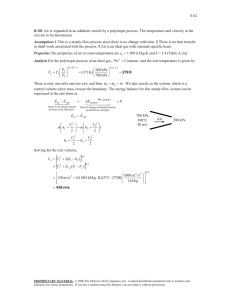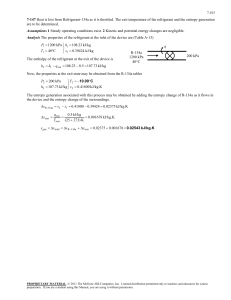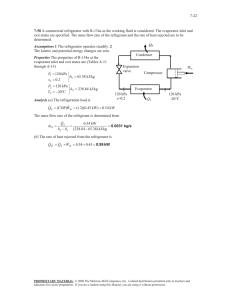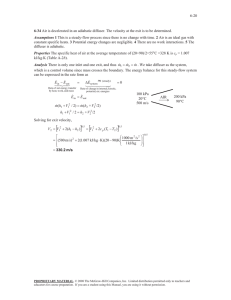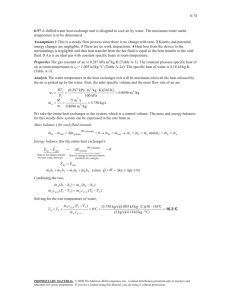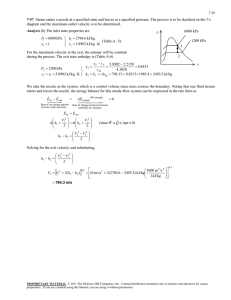cankaya university faculty of engineering and architecture
advertisement
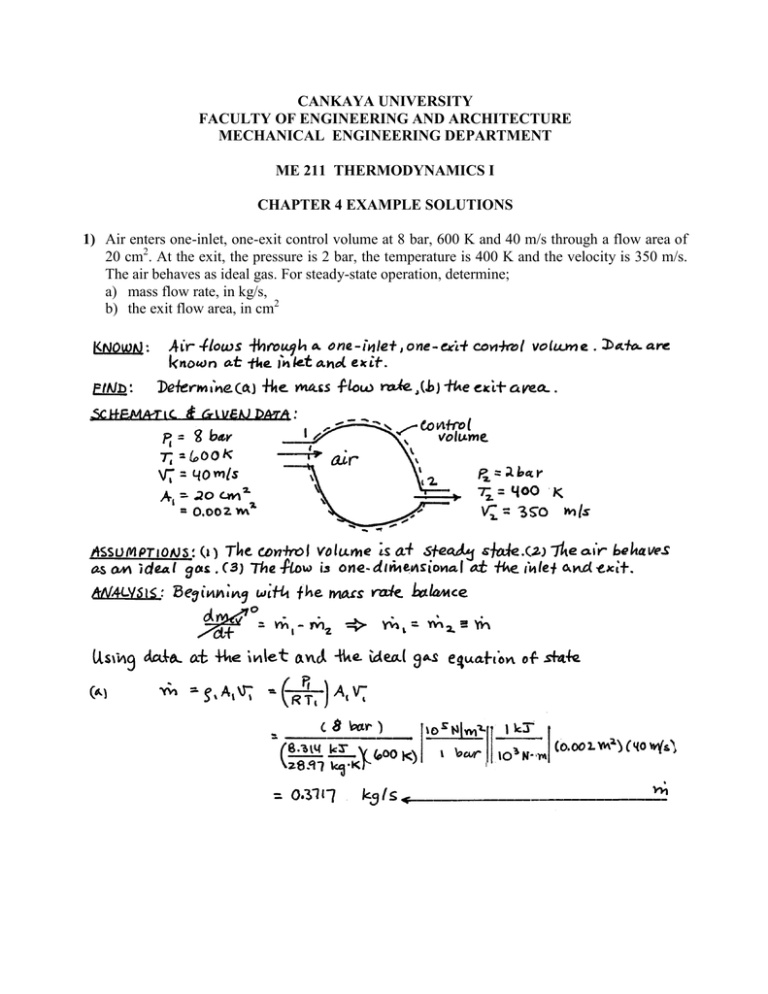
CANKAYA UNIVERSITY FACULTY OF ENGINEERING AND ARCHITECTURE MECHANICAL ENGINEERING DEPARTMENT ME 211 THERMODYNAMICS I CHAPTER 4 EXAMPLE SOLUTIONS 1) Air enters one-inlet, one-exit control volume at 8 bar, 600 K and 40 m/s through a flow area of 20 cm2. At the exit, the pressure is 2 bar, the temperature is 400 K and the velocity is 350 m/s. The air behaves as ideal gas. For steady-state operation, determine; a) mass flow rate, in kg/s, b) the exit flow area, in cm2 2) R134a at 700 kPa and 100 °C enters an adiabatic nozzle with a velocity of 20 m/s and leaves at 320 kPa and 30 °C. Find the exit velocity and the ratio of the inlet to exit areas. 3) Air enters an insulated diffuser operating at steady state with a pressure of 1 bar, a temperature of 300 K and a velocity of 250 m/s. At the exit, the pressure is 1.13 bar and the velocity is 140 m/s. Potential energy effects can be neglected. Using the ideal gas model, a) the ratio of exit flow area to the inlet flow area b) the exit temperature in K 4) Air is to be compressed from 120 kPa and 310 K to 700 kPa and 430 K. a heat loss of 20 kJ/kg occurs during the compression. Δke=0. The mass flow rate is 90 kg/min. Find the required power input. 12686 kJ 1 min 211 kW W min 60 s 5) Air expands through a turbine from 10 bar, 900 K to 1 bar, 500 K. The inlet velocity is small compared to exit velocity of 100 m/s. The turbine operates at steady-state and develops an output of 3200 kW. Heat transfer between the turbine and its surroundings and potential energy effects are negligible. Calculate the mass flow rate of air in kg/s and the exit area in m2. 6) 7) 8) Separate streams of steam and air flow through the turbine and heat exchanger arrangement shown in Fig.P4.108. Steady-state operating data are provided on the figure. Heat transfer with the surroundings can be neglected, as can all kinetic and potential energy effects. Determine: (a) T3, in K, (b) the power output of the second turbine, in kW. 9)A pump steadily delivers water through a hose terminated by nozzle. The exit of the nozzle has a diameter of 2.5 cm and is located 4 m above the pump inlet pipe, which has a diameter of 5 cm. The pressure is equal to 1 bar at both the inlet and the exit, and the temperature is constant at 20oC. The magnitude of the power input required by the pump is 8.6 kW and the acceleration of gravity is g=9.81 m/s2. Determine the mass flow rate delivered by the pump in kg/s. 10)R-134-a is throttled from 800 kPa and 25°C to a final temperature of -20 °C. Find the pressure and internal energy of the refrigerant at the final state. 11)Ammonia enters a heat exchanger operating at steady-state as superheated vapor at 14 bar, 60oC, where it is cooled and condensed to saturated liquid at 14 bar. The mass flow rate of the refrigerant is 450 kg/h. a separate stream of air enters the heat exchanger at 17oC, 1 bar and exits at 42oC, 1 bar. Ignoring heat transfer from the outside of the heat exchanger and neglecting kinetic and potential energy effects, determine mass flow rate of the air, in kg/min. 12)The cooling coil of an air-conditioning system is a heat exchanger in which air passes over tubes through which R-22 flows. Air enters with a volumetric flow rate of 40 m3/min at 27oC, 1.1 bar, and exits at 15oC, 1 bar. Refrigerant enters the tubes at 7 bar with a quality of 16% and exits at 7 bar, 15oC. Ignoring heat transfer from the outside of the heat exchanger and neglecting kinetic and potential energy effects, determine at steady-state; a) the mass flow rate of refrigerant, in kg/min b) the rate of energy transfer, in kJ/min, from the air to the refrigerant 13)A 0.2 m3 tank initially contains R-134a at 8°C and 60% quality. The valve to a supply line is opened and refrigerant at 1 MPa and 120°C is allowed to enter the tank until the pressure reaches 800 kPa, when the valve is closed. At this point, the refrigerant in the tank is saturated vapor. Find: a) the final temperature in the tank, b) the mass of refrigerant that has entered the tank c) the heat transfer between the system and surroundings 14)A balloon initially contains 65 m3 of helium gas at atmospheric conditions of 100 kPa and 22°C. Now helium from a large tank at 150 kPa and 25°C is added to the balloon until the pressure in the balloon is 150 kPa. During the filling process the volume varies linearly with pressure. If not heat transfer takes place during the process, find the final temperature in the balloon.
